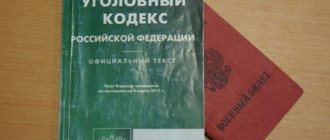ST 213 of the Criminal Code of the Russian Federation.
1. Hooliganism, that is, a gross violation of public order, expressing clear disrespect for society, committed:
a) with the use of violence against citizens or the threat of its use;
b) for reasons of political, ideological, racial, national or religious hatred or enmity, or for reasons of hatred or enmity towards any social group;
c) on railway, sea, inland water or air transport, as well as on any other public transport, -
shall be punishable by a fine in the amount of three hundred thousand to five hundred thousand rubles, or in the amount of the wages or other income of the convicted person for a period of two to three years, or by compulsory labor for a term of up to four hundred eighty hours, or by corrective labor for a term of one to two years, or forced labor for a term of up to five years, or imprisonment for the same period.
2. The same act committed with the use of weapons or objects used as weapons, or by a group of persons, a group of persons by prior conspiracy or an organized group, or associated with resistance to a government official or other person performing duties to protect public order or suppressing a violation of public order order -
shall be punishable by a fine in the amount of five hundred thousand to one million rubles, or in the amount of the wages or other income of the convicted person for a period of three to four years, or by forced labor for a term of up to five years, or by imprisonment for a term of up to seven years.
3. Acts provided for in parts one or two of this article, committed with the use of explosives or explosive devices, -
shall be punished by imprisonment for a term of five to eight years.
Commentary to Art. 213 Criminal Code
1. The objective side of hooliganism consists of actions that constitute a gross violation of public order, expressing clear disrespect for society. The actions that constitute hooliganism are varied: the use of violence against citizens, destruction and damage to other people's property, disruption of public events, stopping or suspending the operation of transport, etc. To qualify such actions as hooliganism, they, firstly, must constitute a gross violation of public order (objective characteristic of actions) and, secondly, must express clear disrespect for society (subjective characteristic of actions) (clause 1 of the Resolution of the Plenum of the Supreme Court of the Russian Federation dated November 15, 2007 N 45 “On judicial practice in criminal cases of hooliganism and other crimes committed out of hooligan motives”). An obligatory sign of the objective side of hooliganism is also the public setting of the crime: hooliganism is committed either in the presence of many people, or secretly, but with results that will inevitably be reflected in the minds of many people.
2. According to Article 213 of the Criminal Code of the Russian Federation, hooliganism has two types. “Ordinary” hooliganism is characterized by a special method of committing a crime: hooliganism must be committed with the use of weapons or objects used as weapons (clause “a”, part 1) (clauses 2 - 4 of the Resolution of the Plenum of the Supreme Court of the Russian Federation of November 15, 2007 . N 45). This distinguishes hooliganism from other crimes committed out of hooligan motives (clause “e”, part 2 of article 112, part 2 of article 115, part 2 of article 116, part 2 of article 167 of the Criminal Code of Russia).
The subjective side of such hooliganism presupposes a hooligan motive (paragraphs 12 - 13 of the Resolution of the Plenum of the Supreme Court of the Russian Federation of November 15, 2007 No. 45).
3. Paragraph “b” of Part 1 implies responsibility for “extremist” hooliganism: it does not have to be committed with the use of weapons or objects used as weapons, but extremist motives for hooliganism must be established.
4. The signs of qualified hooliganism (part 2) are disclosed in paragraphs 7 - 10 of the Resolution of the Plenum of the Supreme Court of the Russian Federation of November 15, 2007 N 45.
5. If necessary, a particularly qualified person is classified according to the totality of crimes.
What are the penalties
The concept of hooliganism provides for different penalties:
- petty hooliganism provides for administrative liability in the form of a fine or forced labor for certain hours in public places;
- malicious hooliganism, qualified under Article 213 of the Criminal Code of the Russian Federation, provides for criminal liability up to imprisonment for various terms up to 8 years.
Administrative punishment for “minor” hooliganism, Art. 20.1 Code of Administrative Offenses of the Russian Federation
A minor violation of public order is punishable under Article 20.1 of the Code of Administrative Offenses of the Russian Federation. Actions that fall under the article:
- violating the silence and calm atmosphere with rude language, using obscene words, threats, shouting;
- pestering citizens with insults, petty extortion (“let me smoke”);
- damaging or destroying someone else's property (breaking dishes in a cafe) without malicious intent;
- disobedience to government officials (police officers and representatives of other services).
Punishment is given to persons who violate the order in a public place: on the street, in a park, in a store - in crowded places. They are given a fine of 500-1000 rubles or arrest for up to 15 days. If during the incident a citizen argued with the police, then an additional fine of 2,500 rubles is issued.
Since March 2021, a paragraph of the article has been approved, which refers to insulting state authorities and symbols of Russia. This administratively punishable act deserves a fine of up to 300 thousand rubles.
Criminal punishment for hooliganism. Article 213 of the Criminal Code of the Russian Federation
Article 213 of the Criminal Code of the Russian Federation describes ways of showing disrespect towards society in a more rude form. The severity of the crime is aggravated by the creation of a dangerous environment for others and the manifestation of aggression. Penalties:
- Imposition of a fine from 300 to 500 thousand rubles.
- Mandatory work up to 480 hours.
- Correctional labor for up to 2 years.
- Imprisonment for up to 5 years.
If hooligan acts are committed by a group of people, then the punishment is different:
- Fine from 500 thousand to 1 million rubles.
- Up to 7 years in prison.
In the case where an aggressive person used explosives in a public place, this is punishable by a prison term of up to 8 years.
On board an airplane, water transport, or in the subway, rowdies create a life-threatening situation for passengers and an emergency situation. Therefore, from 2021, a clause on aggressive actions on public transport has been added to the article. Provided types of punishment:
- fine 300 thousand - 500 thousand rubles;
- a fine equal to 2-3 years' wages;
- compulsory work up to 480 hours;
- correctional labor 1 – 2 years;
- forced labor for up to 5 years;
- imprisonment for up to 5 years.
Second commentary to Art. 213 of the Criminal Code of the Russian Federation
1. The objective side of the first crime (clause “a” of Part 1 of Article 213) is characterized by a socially dangerous act, representing a gross violation of public order, expressing clear disrespect for society. It is a deliberate violation of generally accepted norms and rules of behavior, dictated by the desire of the perpetrator to oppose himself to others, to demonstrate a disdainful attitude towards them.
Such actions can be committed both in relation to a specific person and in relation to an indefinite number of persons.
Mandatory signs of the objective side of hooliganism are the public setting of the crime, although it is not identified in the Criminal Code as constructive, as well as the method of committing the crime: the use of weapons or objects used as weapons.
In cases where, in the process of committing hooliganism, a person uses animals that pose a danger to human life or health, the act, taking into account the specific circumstances of the case, can be qualified under paragraph “a” of Part 1 of Art. 213.
The use of unloaded, faulty, unusable weapons (for example, training weapons) or decorative, souvenir weapons, toy weapons, etc. in the course of committing hooliganism is qualified under paragraph “a” of Part 1 of Art. 213 (clause 4 of the resolution of the Plenum of the Supreme Court of the Russian Federation dated November 15, 2007 No. 45 “On judicial practice in criminal cases of hooliganism and other crimes committed out of hooligan motives”). This position of the Supreme Court has been sharply criticized in science.
From the subjective side, hooliganism is characterized by direct intent and a special motive - hooliganism.
2. The objective side of the second crime (clause “b” of Part 1 of Article 213) is expressed in actions that constitute a gross violation of public order, expressing clear disrespect for society. A mandatory sign of the objective side is the public environment.
The crime is considered completed from the moment the hooligan acts are committed.
The subjective side is characterized by direct intent and a special motive - political, ideological, racial, national or religious hatred or enmity, or based on hatred or enmity towards any social group (extremist motive).
Hooliganism can be committed with the use of weapons or objects used as weapons with an extremist motive; such a crime must be qualified under paragraphs “a”, “b” of Part 1 of Art. 213.
3. The objective side of the third offense of hooliganism is characterized by actions that constitute a gross violation of public order, expressing clear disrespect for society and the circumstances of the place - railway, sea, inland water or air transport, as well as any other public transport.
The subjective side is characterized by direct intent and a special motive - hooliganism.
If a crime is committed with an extremist motive, the act must be qualified under paragraphs “b”, “c” of Part 1 of Art. 213. The commission of the hooliganism in question with the use of weapons or objects used as weapons entails the qualification of a crime committed under paragraphs “a”, “c” of Part 1 of Art. 213.
The subject of the crime is a person who has reached the age of 16 years.
4. Resistance to a government official or other person (Part 2) is active opposition to the relevant persons in the performance of their official or public duties to protect public order and fulfill public duty. It must be in the process of suppressing hooliganism.
Hooligan actions associated with resistance to a representative of the authorities, during which violence was used, both non-dangerous and dangerous to life and health, should be classified as a set of crimes provided for in Part 2 of Art. 213 and the corresponding part of Art. 318 CC.
For the definition of a government representative, see the note to Art. 318 CC.
Persons performing duties for the protection of public order should include military personnel, persons engaged in private detective and security activities, involved in the protection of public safety and public order, officials of local government bodies who, under the special authority of the local government body, carry out functions for the protection of public order.
Other persons suppressing violations of public order are understood as persons, although not vested with any powers, but participating in preventive actions on their own initiative.
5. Causing harm to human health of varying degrees of severity or committing murder for this reason should be qualified under the relevant articles of the Criminal Code, which provide for liability for crimes against the person.
6. A particularly qualified type of hooliganism is its commission with the use of explosives or explosive devices (Part 3).
For the definition of explosives or explosive devices, see the commentary to Art. 222.1 CC.
What is hooliganism?
So, hooliganism is distinguished by the fact that it is antisocial in nature. Disrespect for society manifests itself in different ways: disruption of order, disobedience to established rules, harm to other people's property. As you can see, we have completely different actions ahead of us. In order to somehow simplify the determination of responsibility for their implementation, the legislation contains a simple division of crimes committed into two types:
- Petty hooliganism
. This includes the most harmless and low-risk actions. Statistics show that these crimes are most often committed by teenagers. This crime, for example, includes quarrelsome language with others (and sometimes among themselves), harassment of third parties, etc. The main basis for interpreting certain actions according to this type is a real violation of public order, that is, there should be complaints from people that they are being disturbed by certain persons. Based on the results of the trial, the accused is assigned administrative responsibility. - Criminal hooliganism
. These actions are also distinguished by the fact that they violate public order, however, unlike small ones, they are more dangerous, can be carried out by an organized gang and cause real harm to dozens of people. Very often, such hooliganism encroaches on public safety, which determines such serious responsibility for committing this.
Please note that different types of hooliganism will be punished under different legislative documents. Thus, petty hooliganism is regulated through the Administrative Code, and “major” hooliganism is regulated through the Criminal Code.
Differences from petty hooliganism
Article 20.1 of the Code of Administrative Offenses of the Russian Federation establishes administrative liability for petty hooliganism. At first glance, an administrative offense and a crime are very similar, but there are a number of signs that allow us to differentiate between them.
- Various qualifying features. Petty hooliganism is always accompanied by profanity and damage (destruction) of someone else's property. Hooliganism under Article 213 of the Criminal Code of the Russian Federation is characterized by other circumstances that were indicated earlier (using objects as weapons, committing actions motivated by hatred or enmity, committing criminal acts in public transport).
- Varying levels of disruption to public order. The crime of “Hooliganism” is precisely a gross violation of public order, in contrast to an administrative offense. However, in each specific case, the court independently decides whether a particular act is a gross violation of public order or not. Resolution of the Plenum of the RF Armed Forces No. 45 of November 15, 2007 states that when deciding this issue, courts should take into account the method, time, nature, intensity and other circumstances of the violation.
Thus, hooliganism and petty hooliganism differ both in the degree of public danger (in the first case it is disproportionately higher) and in the qualifying criteria.
“Recently in Russia there has been a tendency to initiate criminal cases against citizens participating in unauthorized rallies. For example, in May 2021, unauthorized protests took place in Yekaterinburg against the construction of a new temple. The result of this action was the initiation of a criminal case under paragraph “a” of Part 1 of Article 213 of the Criminal Code of the Russian Federation against an unidentified person. In addition, about 100 people were brought to administrative responsibility: mainly, they were given fines as sanctions. Consequently, there is a risk of being held accountable for hooliganism for a citizen participating in illegal rallies. However, most often we are talking not about criminal, but about administrative liability for petty hooliganism.
In relation to participants in uncoordinated actions who have committed socially dangerous acts, when qualifying their actions, the question arises of distinguishing between hooliganism and mass riots (Article 212 of the Criminal Code of the Russian Federation). Unlike hooliganism, which encroaches on public order, the object of mass disorder is primarily public safety. In addition, mass riots are characterized by the participation of a large number of people, and the actions of the participants involve the destruction or damage of property, resistance to government officials, and other actions specified by law. It should also be understood that, unlike hooliganism, which is not planned in advance and is committed spontaneously, as a result of spontaneous actions, mass riots are characterized by preliminary organization, coordination of actions, planning and distribution of roles between participants. By its nature, mass riots are a more socially dangerous act than hooliganism, and therefore liability for their commission is more severe.
Code of Administrative Offenses: hooliganism
In the Code of Administrative Offenses of the Russian Federation you can find a special article regulating precisely the features and nuances of actions that can be characterized as petty hooliganism. This is article number 20.1 with the same title - “Petty hooliganism”. The article examines two types of such crimes in gradation from the smallest and safest to the larger. Let's look at them further:
- First type (first part of the article). These are minor public order offences. This may include obscene language in public places or offensive harassment of passers-by. As a rule, such crimes do not cause much damage, however, in some cases they can cause damage to someone else’s property.
- Second type (second part of the article). This may include the same actions as those listed in the previous type, but with an aggravating circumstance in the form of disobedience to a government official. It is important that the executor of power is on duty. If the incident occurs, for example, during his vacation, the crime will no longer apply.
The main problem that the criminal creates in this case is that often these types of crimes violate human rights themselves. Among them are the right to honor and dignity, health, working and living conditions, which are of interest to individual citizens and entire organizations, etc.
Criminal liability for hooliganism
In the 20s of the last century, hooliganism “bloomed” in full. Similar actions were carried out everywhere in Russian cities. This included singing obscene songs on the city streets, molesting girls, using obscene language, damaging monuments and other objects, and drunken fights. This is an incomplete list of possible hooliganism that was spreading catastrophically throughout the country. In this regard, the government decided to take measures to combat such offenses. In 1922, criminal liability for hooliganism was established for the first time. The article was of a universal nature. It provided for punishment in the form of forced labor or imprisonment for up to one year. But it could only be used for not too serious offenses. Punishment for acts of a serious nature had to be established under other articles of the Criminal Code. In 1924, hooliganism was recognized as an administrative tort. Punishments in the form of imprisonment were provided for repeated socially dangerous acts. In 1926, according to the Criminal Code, for committing hooliganism for the first time, the offender was imprisoned for up to three months. If these actions were accompanied by rioting, disorderly conduct, or were committed repeatedly, then they could receive 24 months of imprisonment. At the beginning of 1926, the government launched a campaign to combat this violation of order. In 1935, for malicious hooliganism one could “earn” five years of strict regime.







